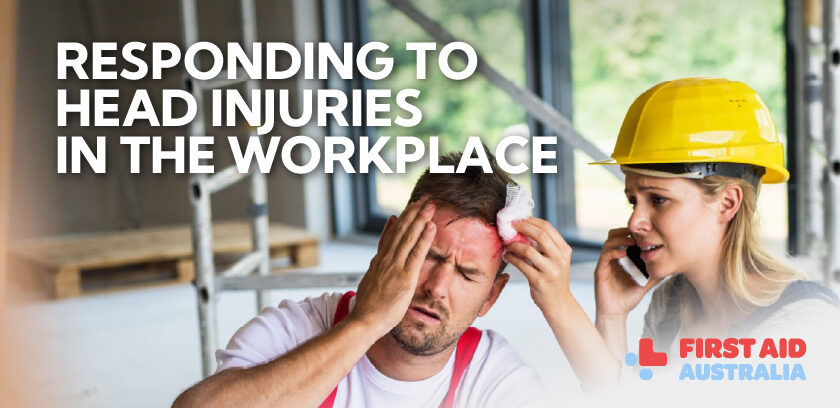The First Aid Australia News+
How to Treat a Head Injury: A Practical Guide
- March 17, 2025
- Posted by: Chris Clarke
- Category: Uncategorized

Head injuries can happen anywhere – at home, work, school, or even during a casual game of footy. Whether it’s a minor bump or a more serious concussion, knowing the right first aid steps can make a huge difference in recovery and preventing complications. Let’s break it down so you’re prepared if the unexpected happens.
What is a Head Injury?
A head injury refers to any trauma to the scalp, skull, or brain. It can range from mild bruising (contusion) to serious conditions like concussions or skull fractures. These injuries can result from falls, sports incidents, car accidents, or even a simple trip over a loose rug.
Common signs of a head injury include:
- A lump on the head or swelling
- Bleeding from the scalp or face
- Dizziness or nausea
- Confusion or memory loss
- Headaches
- Delayed concussion symptoms such as mood changes, sleep disturbances, or difficulty concentrating
One of the most common types of head injuries is a concussion. But what is a concussion exactly? It’s a mild traumatic brain injury that affects how the brain functions. Symptoms may appear immediately or take hours (or even days) to show up, making it crucial to monitor anyone who has suffered a blow to the head.
First Aid for a Head Injury
If someone suffers a head injury, follow these first aid steps:
- Enact your DRSABCD
- Send for Help if Needed – Call 000 immediately if the person:
- Was unconscious, even briefly
- Has persistent vomiting
- Has clear fluid leaking from the ears or nose
- Has difficulty speaking or coordinating movements
- Has a seizure
- Is bleeding heavily
- Has difficulty speaking or walking
- Experiences worsening symptoms over time
- Other considerations:
- Stop Any Bleeding – Use a clean cloth or bandage to apply gentle pressure. If the wound is deep or won’t stop bleeding, seek medical help.
- Keep Them Still – Encourage the person to stay still and avoid unnecessary movement, especially if there’s a chance of neck or spinal injury.
- Apply a Cold Pack – If there’s a lump or swelling, apply a cold pack wrapped in a cloth for 15-20 minutes.
- Monitor for Signs of Concussion – Confusion, dizziness, or delayed symptoms could indicate a concussion. Proper concussion care includes rest and avoiding physical activity until cleared by a medical professional.
- Watch for Deterioration – If symptoms worsen (vomiting, severe headache, drowsiness), seek urgent medical attention.
- Do Not Give Painkillers Immediately – Some medications can mask symptoms of serious head injuries.
What Are the Right First Aid Supplies Needed to Treat a Head Injury?
Having a well-stocked first aid kit can help manage head injuries effectively. Some essential items include:
- Sterile dressings and bandages – To control bleeding and protect wounds.
- Instant cold packs – Useful for reducing swelling and pain.
- Gloves – To maintain hygiene when treating wounds.
- Triangular bandage – Can be used to stabilise the head or neck if necessary.
- Torch – Handy for checking pupil reaction in low-light situations.
- First aid manual or instructions – Useful for quick reference.
A well-equipped first aid kit is essential, whether you’re at home, work, or out on the sports field.
What First Aid Training is Needed to Provide First Aid for a Head Injury?
While basic knowledge of first aid is valuable, undertaking professional first aid training is the best way to ensure you’re prepared for emergencies. A first aid course will teach you how to:
- Conduct a thorough coma test to assess consciousness.
- Recognise signs of serious brain injuries and when to call emergency services.
- Provide CPR and manage an unconscious casualty.
- Properly assess how long a concussion lasts and the appropriate recovery steps.
If you’re involved in sports, work with children, or have a physically active lifestyle, first aid training is especially useful.
Final Thoughts
Head injuries should never be ignored, whether it’s a small lump on the head or a suspected concussion. Prompt treatment and proper monitoring can help prevent complications and ensure a full recovery. If in doubt, seek medical advice—especially when dealing with children or head injuries sustained in sport.
By staying informed and prepared, you can make a real difference when it matters most.
Call to Action:
Take the next step in your first aid journey — enroll in our first aid training today and become certified in handling head injuries and other medical emergencies. Be prepared for anything with the right skills and the right tools!
Leave a Reply Cancel reply
You must be logged in to post a comment.